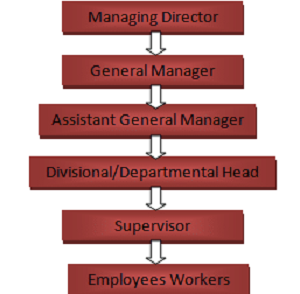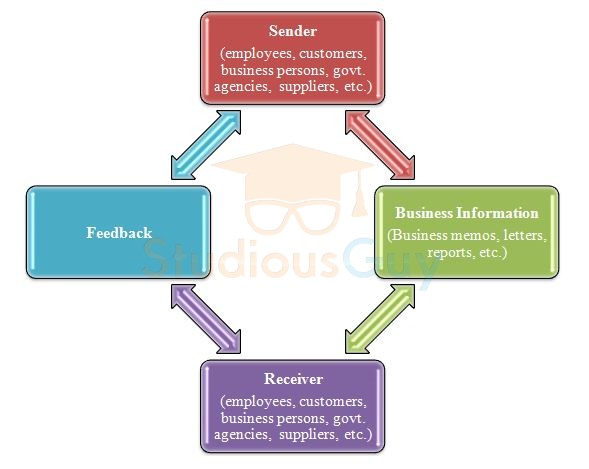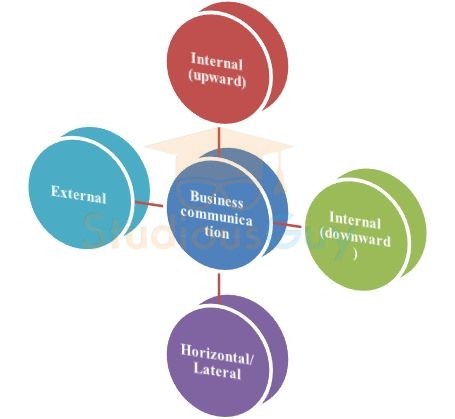Index of Article (Click to Jump)
·
Types of Business Communication along with Examples
·
Importance of
Business Communication
·
Business Communication
Methods
·
Business Communication
Functions
Introduction
Communication is an essential element in the success of any business. The process of transferring information from one person to another, within and outside the business environment, is termed as ‘Business Communication.’ The term ‘Business Communication’ is derived from general communication which is associated with business activities. In other terms, communication between business parties or people for business-related tasks is considered as ‘Business Communication.’
Definitions
Different scholars have given different definitions of Business
Communication. Few of them are mentioned below:
According to Ricks and Gow defined Business
Communication as a system that is responsible to affect change throughout the
whole organization.
According to W.H. Business
Communication is exchanging business-related different views, ideas, and news
within the related parties.
Prof. J. Haste stated that when the communication occurs between either two or more than two business people for the purpose of effective organization and administration of business then it is considered as Business Communication.
Effective
business communication is the way employees and management communicate to
achieve organizational goals. The objective is to improve organizational
efficiency by reducing mistakes. Business Communication includes different
aspects like marketing, public relations, customer relations, corporate and
interpersonal communication, etc.
Basic elements of Business communication
§
Business information
§
Receiver
§
Feedback
The above elements indicate business communication as a process
in which information or news related to business is exchanged between different
business parties like customers, suppliers, business clients, employees, etc.
for the purpose of effective administration of the business.
Moreover, it involves a regular flow of information and feedback is considered as a crucial and important aspect of business communication. Due to different levels of hierarchy and involvement of a huge number of people, business communication plays an important role in different management functions i.e. planning, coordinating, organizing, directing, and controlling.
Types of Business Communication along with Examples
There are 4 main types of business communication in any organization or business i.e.
Internal Business Communication means communication that occurs within the members of the organization. This communication includes both formal and informal communication. Also, different departments that transmit communication by different means to employees come under internal communication. Internal communication should be effective as it is a vital source of viewing and representing organizational issues. Effective internal business communication may increase job satisfaction level, productivity, the efficiency of employees by decreasing their turnover and grievances and helps in increasing profits.
We’ve thoroughly explained the Internal Business Communication in a separate article here 
t is further categorized as internal (upward) communication and internal (downward) communication.
a. Internal (Upward) Communication: This type of internal communication involves the bottom to the top management approach. Here, the information flows from subordinates to managers or any person that is on the upper in the hierarchy level.
For example, employees of the HR department of an organization prepare an attrition report and communicate the same to the HR Manager. The attrition report consists of information on the monthly or annual employee turnover of an organization and reasons for the same. This helps the HR Manager to understand the cause of attrition and to take corrective measures on time to reduce employee turnover.
The characteristics of upward internal business communication include:
§
It includes bottom to top approach i.e. subordinates to
superiors.
§
Its nature is participative.
§
The main purpose is to provide timely feedback, suggestions,
making requests, escalating any issues or concerns, etc. to superiors.
§ The flow of the information is from the lower level to the upper level
b.
Internal (Downward) Communication: In downward communication, the information
flows from the top-level management to the employees in an organization. This
information is related to passing on instructions to subordinates or employees
to do their respective tasks. Downward communication is being used by managers
to communicate different goals, procedures and policies, guidelines, decisions,
instructions, etc. to their subordinates.
The process of downward communication in business includes passing on messages from the top level to the lower level through the chain of hierarchy. This type of communicatio
n can be in oral or written form. The written form includes different notices, manuals, news display in electronic form, etc. whereas, the oral form of downward communication includes different face-to-face conversations, telephonic communication, meetings, etc.
§
It includes top to bottom approach i.e. superiors to
subordinates.
§
Its nature is directive.
§
Main purpose is to communicate organizational objective, plans
and procedures, instructions, etc. to subordinates.
§ The flow of the information is from the upper level to the lower level.
For example, the Marketing head of an organization is supposed to communicate about market trends, customer needs and expectations, product demand scenario, etc. to a production head for production of products accordingly.
Similarly, the HR manager of an organization works with different department heads for different functioning like hiring, training needs of employees, performance appraisals, welfare activities, etc.
3. External Business Communication
Communication with people who are external to the organization is known as external business communication. These people can be customers or shareholders or suppliers or partners or regulatory bodies, etc.
We’ve thoroughly explained the External Business Communication in a separate article here
For example, the purchase department supervisor may communicate with vendors for purchase quotations of raw-material and similarly, the sales department communicates with customers for sales of goods or services.
External communication facilitates increasing sales volume, effective operations, an increase in profits of organization, etc. This ultimately results in increasing corporate image, goodwill and overall performance of the organization by achieving its goals and customer satisfaction.
Importance of Business Communication
1. Helps in increasing productivity: Effective business communication increases the productivity of staff by boosting up teamwork. It creates a trustworthy and understanding environment among employers and employees. Effective communication is related to cooperating with employees and understanding their needs and desires. By doing so, employees are able to accomplish their tasks more effectively and efficiently. Also, the scope of doing mistakes or errors during their work minimizes due to effective communication.
2. Helps in increasing customers: Customers are an important part of any business and effective business communication can facilitate in attracting new customers and retain the current customers. A well-defined marketing strategy and public relations campaign run by an organization generates the interest of customers in its goods or services and helps in building the corporate image in customers.
3. Enhances business partnerships: Business Communication also improves partnerships in business. It plays a significant role in dealing with external business clients or vendors. Vendors may be required to communicate on products regularly for improvements. Also, an effective and harmonious relationship with other businesses determines the further success of an organization. A business unit that has developed its image as an entity for easy partnership through its effective communication can attract other business units for forming business relationships with them.
4. Facilitates innovations in business: Effective business communication helps in business innovations as well as it facilitates employees to convey their ideas and suggestions openly. Similarly, at the time of launching any new product in the market, effective communication ensures the performance of the sales team, market acceptance of the product, fast delivery of products in the market, etc.
5. Information exchange: Business communication is required by an organization for exchanging information with internal and external stakeholders. This helps in achieving its goals effectively.
6. Preparation of plans and policies: Through effective business communication, organizations can make their plans and policies properly. Relevant information is required for preparing these plans and policies. Through communication, different managers source information through reliable channels.
7. Execution or implementation of plans and policies: To implement or execute the prepared policies and plans in a timely manner, managers are supposed to communicate these throughout the organization. Through effective communication, they are able to disseminate plans and policies to the internal and external stakeholders.
8. Boost the efficiency of employees: Effective business communication plays a key role in increasing the efficiency of staff. Through communication, different plans and policies, critical issues, goals of an organization, etc. are described to employees that enhance their knowledge and make them efficient to do their tasks effectively.
9. Goals achievement: Through effective business communication employees become attentive and productive in doing their jobs that result in the timely accomplishment of their tasks and easy goals attainment.
10. Helps in solving problems or issues: Through different communication channels, managers get information about different routine and non-routine issues and based upon that they can take required actions to sort out those issues.
11. Facilitates decision-making: Effective decisions require up-to-date information. Using effective communication, managers can acquire information from different sources and can utilize it for making correct decisions.
12. Improves worker-management industrial relations: In the workplace, workers and management have an industrial relation. The success of any business depends upon the healthy industrial relation. Business communication plays a significant role in maintaining harmony in this.
13. Helps in brand and product/service promotions: In today’s competitive business environment, lots of companies offer similar kinds of products or services. To sell their products in a good manner, businesses need better communication to promote products and services in an effective way.
14. Reduces chances of conflicts: Through effective communication different business parties can exchange information in a smooth way. This results in fewer conflicts, controversies, arguments between them.
15. Increases employee satisfaction level:
Effective communication which is fair and smooth creates better mutual bonding and the understanding between employees and management. This helps in increasing the satisfaction level among employees who put their maximum efforts to achieve the goals.
16. Increases employee loyalty: Through effective business communication, employees are well informed about their performance from time to time. Also, employees get appreciation, rewards in both monetary and non-monetary terms for their better performance. This enhances their loyalty towards the organization.
17. Enhances efficiency of managers and leads to effective leadership: Effective business communication leads to an increase in the operational efficiency of managers. With the help of fair communication, managers can perform different managerial functions like planning, directing, organizing, controlling, etc. smoothly. Moreover, if communication is effective then only effective leadership can be taken place. For qualitative leadership activities, a proper and smooth system of communication in business is essential.
18. Proper functioning of different departments: If information is shared smoothly and effectively in inter-departments and intra-departments then different departments of any business like accounts, finance, purchase, operations, HR, IT, and production, etc. can do their tasks more accurately and timely.
Business Communication Methods
Different methods of communicating in a business are as below:
1. In-person (Face-to-Face) Business Communication: In-person communication is the most common and preferred method of business communication. As it is generally in the form of meetings or conferences which is face to face communication format. This requires refined in-person skills. This method also includes non-verbal communication i.e. body language. While having a conversation between two or more people in business, body language like gestures, facial expression, etc. also play a vital role in communicating a person’s attitude towards others.
Good listening skills are also an element in better in-person communication. Most of the business communication includes listening skills to understand fast discussions.
2. Communication by email system: An e-mail has become the most widely used communication system in any business. Due to its feature of sending and receiving mass or multiple messages at a time, email is considered as one of the preferred methods in business communication. It also increases efficiency as emails can be sent and responded in fast mode. The conversation through email can be among two or more than two people and is the best substitute for formal face to face meetings as discussions can be done in an email system.
3. Web conferencing: In the web conferencing method of business communication, the internet is being used for communication in meetings, conferences, presentations, seminars, and imparting training. It includes features like sharing of files, screens, real-time chatting, recording, etc. This can be considered as the most effective way of interacting with people sitting at different locations. Web conferencing is done by using the phone (teleconferencing) or video equipment (videoconferencing).
Workplaces also opt for the teleconferencing method of business communication. If it’s not feasible for people of an organization or business to attend a physical meeting or conference then communicating through telephone conferencing is an effective method. This also saves travel expenses as people who often require extensive traveling for business purposes so they can communicate through teleconference by sitting in their office.
Videoconferencing is also similar to teleconferencing except in videoconferencing one can see the people whom to communicate with. This requires video conferencing equipment that is arranged by the IT department of a business.
4. Written communication: Written business communication is a formal and detailed form of communication than other methods. Different written communication tools include formal letters, brochures, posters, etc.
5. Other methods: There are other business communication methods like an instant messaging system. This technology is easy to use as one can easily connect with people while working offsite and have conversations without waiting so long.
Business Communication: Definition, Types, Examples, Importance, Methods, Functions
Introduction
Communication is an essential element in the success of any business. The process of transferring information from one person to another, within and outside the business environment, is termed as ‘Business Communication.’ The term ‘Business Communication’ is derived from general communication which is associated with business activities. In other terms, communication between business parties or people for business-related tasks is considered as ‘Business Communication.’ 
Definitions
Different scholars have given different definitions of Business Communication. Few of them are mentioned below:
According to Ricks and Gow defined Business Communication as a system that is responsible to affect change throughout the whole organization.
According to W.H. Business Communication is exchanging business-related different views, ideas, and news within the related parties
Prof. J. Haste stated that when the communication occurs between either two or more than two business people for the purpose of effective organization and administration of business then it is considered as Business Communication.
Effective business communication is the way employees and management communicate to achieve organizational goals. The objective is to improve organizational efficiency by reducing mistakes. Business Communication includes different aspects like marketing, public relations, customer relations, corporate and interpersonal communication, etc.
Basic elements of Business communication:
- Sender
- Business information
- Receiver
- Feedback
The above elements indicate business communication as a process in which information or news related to business is exchanged between different business parties like customers, suppliers, business clients, employees, etc. for the purpose of effective administration of the business.
Moreover, it involves a regular flow of information and feedback is considered as a crucial and important aspect of business communication. Due to different levels of hierarchy and involvement of a huge number of people, business communication plays an important role in different management functions i.e. planning, coordinating, organizing, directing, and controlling.
Types of Business Communication along with Examples
There are 4 main types of business communication in any organization or business i.e.
1. Internal Business Communication
Internal Business Communication means communication that occurs within the members of the organization. This communication includes both formal and informal communication. Also, different departments that transmit communication by different means to employees come under internal communication. Internal communication should be effective as it is a vital source of viewing and representing organizational issues. Effective internal business communication may increase job satisfaction level, productivity, the efficiency of employees by decreasing their turnover and grievances and helps in increasing profits.
We’ve thoroughly explained the Internal Business Communication in a separate article here 
It is further categorized as internal (upward) communication and internal (downward) communication.
a. Internal (Upward) Communication: This type of internal communication involves the bottom to the top management approach. Here, the information flows from subordinates to managers or any person that is on the upper in the hierarchy level.
For example, employees of the HR department of an organization prepare an attrition report and communicate the same to the HR Manager. The attrition report consists of information on the monthly or annual employee turnover of an organization and reasons for the same. This helps the HR Manager to understand the cause of attrition and to take corrective measures on time to reduce employee turnover.
The characteristics of upward internal business communication include:
- It includes bottom to top approach i.e. subordinates to superiors.
- Its nature is participative.
- The main purpose is to provide timely feedback, suggestions, making requests, escalating any issues or concerns, etc. to superiors.
- The flow of the information is from the lower level to the upper level.
b. Internal (Downward) Communication: In downward communication, the information flows from the top-level management to the employees in an organization. This information is related to passing on instructions to subordinates or employees to do their respective tasks. Downward communication is being used by managers to communicate different goals, procedures and policies, guidelines, decisions, instructions, etc. to their subordinates.
The process of downward communication in business includes passing on messages from the top level to the lower level through the chain of hierarchy. This type of communication can be in oral or written form. The written form includes different notices, manuals, news display in electronic form, etc. whereas, the oral form of downward communication includes different face-to-face conversations, telephonic communication, meetings, etc.
For example, the top-level management may instruct managers of different departments on certain new rules and regulations in the work area that need to be carried out in routine activities of different departments. Like there may be a change in the office working hours or office timings by the management and the same is communicated to employees by circular or notice or through the e-mail system.
The characteristics of downward internal business communication include:
- It includes top to bottom approach i.e. superiors to subordinates.
- Its nature is directive.
- Main purpose is to communicate organizational objective, plans and procedures, instructions, etc. to subordinates.
- The flow of the information is from the upper level to the lower level.
2. Horizontal/Lateral Business Communication
Lateral or horizontal communication is related to communication among co-workers i.e. either verbal communication or written communication. This may include inter-departmental communication or communication between cross-departments and can be between people of the same or similar rank in a company. This is a crucial communication to achieve the desired results. So, this communication happens among employees having an equal hierarchy level. To achieve the functional effectiveness of different organizational units, horizontal or lateral communication is required for seeking mutual cooperation and mutual help.
For example, the Marketing head of an organization is supposed to communicate about market trends, customer needs and expectations, product demand scenario, etc. to a production head for production of products accordingly.
Similarly, the HR manager of an organization works with different department heads for different functioning like hiring, training needs of employees, performance appraisals, welfare activities, etc.
3. External Business Communication
Communication with people who are external to the organization is known as external business communication. These people can be customers or shareholders or suppliers or partners or regulatory bodies, etc.
We’ve thoroughly explained the External Business Communication in a separate article here 
For example, the purchase department supervisor may communicate with vendors for purchase quotations of raw-material and similarly, the sales department communicates with customers for sales of goods or services.
External communication facilitates increasing sales volume, effective operations, an increase in profits of organization, etc. This ultimately results in increasing corporate image, goodwill and overall performance of the organization by achieving its goals and customer satisfaction.
Importance of Business Communication

Importance of business communication in an organization can be seen in the below points:
1. Helps in increasing productivity: Effective business communication increases the productivity of staff by boosting up teamwork. It creates a trustworthy and understanding environment among employers and employees. Effective communication is related to cooperating with employees and understanding their needs and desires. By doing so, employees are able to accomplish their tasks more effectively and efficiently. Also, the scope of doing mistakes or errors during their work minimizes due to effective communication.
2. Helps in increasing customers: Customers are an important part of any business and effective business communication can facilitate in attracting new customers and retain the current customers. A well-defined marketing strategy and public relations campaign run by an organization generates the interest of customers in its goods or services and helps in building the corporate image in customers.
3. Enhances business partnerships: Business Communication also improves partnerships in business. It plays a significant role in dealing with external business clients or vendors. Vendors may be required to communicate on products regularly for improvements. Also, an effective and harmonious relationship with other businesses determines the further success of an organization. A business unit that has developed its image as an entity for easy partnership through its effective communication can attract other business units for forming business relationships with them.
4. Facilitates innovations in business: Effective business communication helps in business innovations as well as it facilitates employees to convey their ideas and suggestions openly. Similarly, at the time of launching any new product in the market, effective communication ensures the performance of the sales team, market acceptance of the product, fast delivery of products in the market, etc.
5. Information exchange: Business communication is required by an organization for exchanging information with internal and external stakeholders. This helps in achieving its goals effectively.
6. Preparation of plans and policies: Through effective business communication, organizations can make their plans and policies properly. Relevant information is required for preparing these plans and policies. Through communication, different managers source information through reliable channels.
7. Execution or implementation of plans and policies: To implement or execute the prepared policies and plans in a timely manner, managers are supposed to communicate these throughout the organization. Through effective communication, they are able to disseminate plans and policies to the internal and external stakeholders.
8. Boost the efficiency of employees: Effective business communication plays a key role in increasing the efficiency of staff. Through communication, different plans and policies, critical issues, goals of an organization, etc. are described to employees that enhance their knowledge and make them efficient to do their tasks effectively.
9. Goals achievement: Through effective business communication employees become attentive and productive in doing their jobs that result in the timely accomplishment of their tasks and easy goals attainment.
10. Helps in solving problems or issues: Through different communication channels, managers get information about different routine and non-routine issues and based upon that they can take required actions to sort out those issues.
11. Facilitates decision-making: Effective decisions require up-to-date information. Using effective communication, managers can acquire information from different sources and can utilize it for making correct decisions.
12. Improves worker-management industrial relations: In the workplace, workers and management have an industrial relation. The success of any business depends upon the healthy industrial relation. Business communication plays a significant role in maintaining harmony in this.
13. Helps in brand and product/service promotions: In today’s competitive business environment, lots of companies offer similar kinds of products or services. To sell their products in a good manner, businesses need better communication to promote products and services in an effective way.
14. Reduces chances of conflicts: Through effective communication different business parties can exchange information in a smooth way. This results in fewer conflicts, controversies, arguments between them.
15. Increases employee satisfaction level:
Effective communication which is fair and smooth creates better mutual bonding and the understanding between employees and management. This helps in increasing the satisfaction level among employees who put their maximum efforts to achieve the goals.
16. Increases employee loyalty: Through effective business communication, employees are well informed about their performance from time to time. Also, employees get appreciation, rewards in both monetary and non-monetary terms for their better performance. This enhances their loyalty towards the organization.
17. Enhances efficiency of managers and leads to effective leadership: Effective business communication leads to an increase in the operational efficiency of managers. With the help of fair communication, managers can perform different managerial functions like planning, directing, organizing, controlling, etc. smoothly. Moreover, if communication is effective then only effective leadership can be taken place. For qualitative leadership activities, a proper and smooth system of communication in business is essential.
18. Proper functioning of different departments: If information is shared smoothly and effectively in inter-departments and intra-departments then different departments of any business like accounts, finance, purchase, operations, HR, IT, and production, etc. can do their tasks more accurately and timely.
Business Communication Methods
Different methods of communicating in a business are as below:
1. In-person (Face-to-Face) Business Communication: In-person communication is the most common and preferred method of business communication. As it is generally in the form of meetings or conferences which is face to face communication format. This requires refined in-person skills. This method also includes non-verbal communication i.e. body language. While having a conversation between two or more people in business, body language like gestures, facial expression, etc. also play a vital role in communicating a person’s attitude towards others.
Good listening skills are also an element in better in-person communication. Most of the business communication includes listening skills to understand fast discussions.
2. Communication by email system: An e-mail has become the most widely used communication system in any business. Due to its feature of sending and receiving mass or multiple messages at a time, email is considered as one of the preferred methods in business communication. It also increases efficiency as emails can be sent and responded in fast mode. The conversation through email can be among two or more than two people and is the best substitute for formal face to face meetings as discussions can be done in an email system.
3. Web conferencing: In the web conferencing method of business communication, the internet is being used for communication in meetings, conferences, presentations, seminars, and imparting training. It includes features like sharing of files, screens, real-time chatting, recording, etc. This can be considered as the most effective way of interacting with people sitting at different locations. Web conferencing is done by using the phone (teleconferencing) or video equipment (videoconferencing).
Workplaces also opt for the teleconferencing method of business communication. If it’s not feasible for people of an organization or business to attend a physical meeting or conference then communicating through telephone conferencing is an effective method. This also saves travel expenses as people who often require extensive traveling for business purposes so they can communicate through teleconference by sitting in their office.
Videoconferencing is also similar to teleconferencing except in videoconferencing one can see the people whom to communicate with. This requires video conferencing equipment that is arranged by the IT department of a business.
4. Written communication: Written business communication is a formal and detailed form of communication than other methods. Different written communication tools include formal letters, brochures, posters, etc.
5. Other methods: There are other business communication methods like an instant messaging system. This technology is easy to use as one can easily connect with people while working offsite and have conversations without waiting so lo
Business Communication Functions
1. Communicating job functions to employees: Informing about assigned job roles is a crucial key function of business communication. Team members having clarity on expected job tasks and how they can contribute to achieving objectives of the organization by fulfilling their job functions, they can contribute more to the completion of their assigned tasks. In the absence of clarity of their roles, employees might not be able to complete their work as expected.
2. Providing adequate feedback: Providing timely and accurate feedback to employees and customers is also an important function of business communication. The performance of employees can be enhanced by providing regular feedback to them regarding their work performance and competencies. This helps them to understand their current skill set, strengths and also they can fill any gap in case of any shortage of required skills. Regular feedback from customers and other stakeholders on products and services of business facilitates the improvement in the production process and quality.
Different informative communication lies in an organization like job descriptions, assigned targets to achieve, performance management, etc.
3. Convincing clients: Business communication is also often used to convince prospective customers, clients and business partners in order to finish a business deal or transaction. This type of communication can be in both oral and written form like a Sales Officer may convince a client on phone call or in written form i.e. providing a mass advertisement in magazine or newspaper for a new product launch or exciting offers on existing products. Both credibility and emotions are an important element of this function of communication. Moreover, this type of communication can be utilized in PR (public relations) activities and to build the organization’s brand image.
4. Employee motivation for better decision-making: Communication in businesses is used in a strategic form to enhance the decision-making capability of employees related to their daily activities and for their long-term objectives related to the business. Like if performance-based bonuses or incentives are communicated among employees effectively then it motivates employees to contribute to the organization’s growth more efficiently and they can achieve their work expectations in a timely manner.
5. Building social bonds: Communication has a critical role in supporting employees to build a social circle or bond. Some organizations have an open culture or work environment in which employees from all levels can communicate with each other and their superiors freely. Other organizations prefer to follow a hierarchy or chain of command in communication.
When employees have a social bond with people whom they work with like their colleagues, supervisors, clients, etc., then their job efficiency improves as the team spirit increases.
























